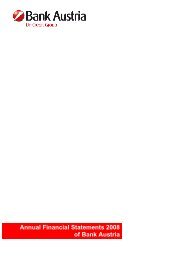Annual Financial Statements 2010 of Bank Austria
Annual Financial Statements 2010 of Bank Austria
Annual Financial Statements 2010 of Bank Austria
You also want an ePaper? Increase the reach of your titles
YUMPU automatically turns print PDFs into web optimized ePapers that Google loves.
Consolidated <strong>Financial</strong> <strong>Statements</strong> in accordance with IFRSs<br />
A – Accounting policies (CoNTINuED)<br />
<strong>Financial</strong> assets and financial liabilities at fair value through pr<strong>of</strong>it or loss<br />
<strong>Financial</strong> assets at fair value through pr<strong>of</strong>it or loss include financial assets held for trading and financial assets designated as at fair value through<br />
pr<strong>of</strong>it or loss upon initial recognition.<br />
<strong>Financial</strong> assets and financial liabilities held for trading (HfT)<br />
<strong>Financial</strong> assets are classified as held for trading if they are acquired for the purpose <strong>of</strong> selling or repurchasing them in the near term. When an<br />
HfT financial instrument is recognised initially, it is measured at its fair value excluding transaction costs that are directly recognised in pr<strong>of</strong>it or<br />
loss. After initial recognition, an entity shall measure these financial instruments at their fair value through pr<strong>of</strong>it or loss. A gain or loss arising<br />
from sale or redemption or a change in the fair value <strong>of</strong> an HfT financial instrument is recognised in the income statement item Gains and losses<br />
on financial assets and liabilities held for trading.<br />
<strong>Financial</strong> assets held for trading include securities held for trading and positive market values <strong>of</strong> derivative financial instruments, recognised at<br />
their fair values. To determine fair values, market prices and quotes via Bloomberg, Reuters, MarkIT and other price indications from the interbank<br />
market etc. are used. Where such prices or quotes are not available, values based on present values or option pricing models are applied.<br />
The item <strong>Financial</strong> liabilities held for trading shows negative market values <strong>of</strong> derivative financial instruments and short positions held in the<br />
trading portfolio. To determine fair values, market prices and quotes via Bloomberg, Reuters, MarkIT and other price indications from the interbank<br />
market etc. are used. Where such prices or quotes are not available, values based on present value calculations or option pricing models are<br />
applied.<br />
At fair value through pr<strong>of</strong>it or loss (fair value option)<br />
When financial assets and financial liabilities are recognised initially, they may be classified as financial assets and financial liabilities at<br />
fair value through pr<strong>of</strong>it or loss if certain requirements are met (either reduction <strong>of</strong> valuation inconsistencies between related financial instruments,<br />
or inclusion in a group <strong>of</strong> financial instruments managed at their fair values on the basis <strong>of</strong> an investment and risk strategy).<br />
In UniCredit <strong>Bank</strong> <strong>Austria</strong>’s statement <strong>of</strong> financial position, financial assets/liabilities at fair value through pr<strong>of</strong>it or loss include only those financial<br />
instruments which were designated as at fair value through pr<strong>of</strong>it or loss upon initial recognition.<br />
Available-for-sale financial assets (AfS)<br />
Available-for-sale financial instruments include debt instruments and equity instruments. Equity instruments classified as available for sale are<br />
those which are not classified as held for trading or at fair value through pr<strong>of</strong>it or loss. To determine their fair values, the methods described in<br />
“Fair values – fair value hierarchy” below are used. Changes in fair values resulting from remeasurement are recognised in a component <strong>of</strong> equity<br />
(available-for-sale reserve) with no effect on income until the disposal <strong>of</strong> the financial asset. Impairment losses are recognised in income. Reversals<br />
<strong>of</strong> impairment losses on equity instruments are recognised in the available-for-sale reserve within equity; reversals <strong>of</strong> impairment losses on<br />
debt instruments are recognised in pr<strong>of</strong>it or loss.<br />
Shares in companies which are neither consolidated nor accounted for under the equity method are classified as available for sale.<br />
Held-to-maturity investments (HtM)<br />
Non-derivative financial assets with fixed or determinable payments and fixed maturity are classified as held-to-maturity investments if the Group<br />
has the positive intention and ability to hold them to maturity. After initial recognition, held-to-maturity investments are recognised at amortised<br />
cost using the effective interest method, with any reduction for impairment. Impairment losses within the meaning <strong>of</strong> IAS 39.63 are recognised in<br />
pr<strong>of</strong>it or loss in the item Impairment losses on held-to-maturity investments.<br />
Loans and receivables<br />
Loans and receivables are non-derivative financial assets with fixed or determinable payments that are not quoted in an active market. After initial<br />
recognition such financial assets are measured at amortised cost using the effective interest method, with any reduction for impairment. The<br />
computation <strong>of</strong> amortised cost includes a premium or discount upon acquisition, and fees or costs constituting an integral part <strong>of</strong> the effective<br />
interest rate. Income from amortisation using the effective interest method is included in the income statement as part <strong>of</strong> financial income.<br />
Impairment losses are recognised in the income statement as financial expenses.<br />
<strong>Bank</strong> <strong>Austria</strong> · <strong>Annual</strong> <strong>Financial</strong> <strong>Statements</strong> <strong>2010</strong><br />
64
















